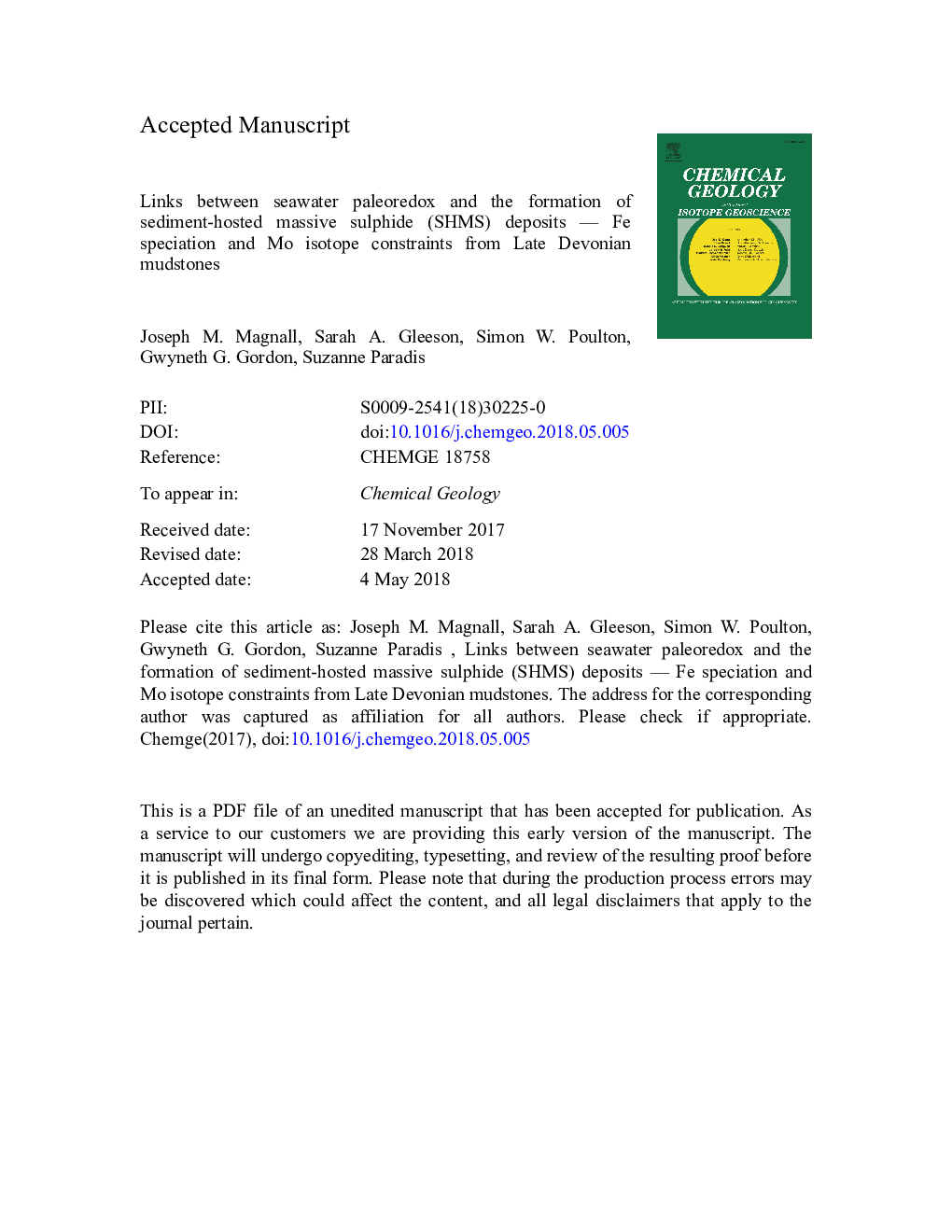| کد مقاله | کد نشریه | سال انتشار | مقاله انگلیسی | نسخه تمام متن |
|---|---|---|---|---|
| 8910193 | 1637484 | 2018 | 48 صفحه PDF | دانلود رایگان |
عنوان انگلیسی مقاله ISI
Links between seawater paleoredox and the formation of sediment-hosted massive sulphide (SHMS) deposits - Fe speciation and Mo isotope constraints from Late Devonian mudstones
دانلود مقاله + سفارش ترجمه
دانلود مقاله ISI انگلیسی
رایگان برای ایرانیان
کلمات کلیدی
موضوعات مرتبط
مهندسی و علوم پایه
علوم زمین و سیارات
ژئوشیمی و پترولوژی
پیش نمایش صفحه اول مقاله

چکیده انگلیسی
Many models of sediment hosted massive sulphide (SHMS) deposit formation invoke basin restriction events that resulted in long-term stagnation and anoxia, in which sulphidic (euxinic) conditions ultimately prevailed. Euxinic conditions are then thought to provide a chemical trap for hydrothermally exhaled base metals. Here, we present Fe speciation and Mo isotope data for organic-rich mudstones from two drill-holes intersecting Upper Devonian strata, deposited along the passive margin of ancestral North America. One drill-hole intersects a 35â¯m thick sequence of SHMS mineralisation, while the other intersects correlative, un-mineralised strata. All samples have high FeHR/FeT values (>0.38), indicating water-column anoxia. For the majority of samples in the un-mineralised drill-hole, the levels of pyritisation fall below the threshold typically used to define euxinic conditions (FePY/FeHRâ¯â¤â¯0.70). In contrast, higher levels of pyritisation in the mineralised drill-hole (median FePY/FeHRâ¯=â¯0.86) likely developed via diagenetic pyrite enrichment. Whereas Pb and Zn are negatively correlated with Mo, Mo-U co-variation is consistent with Fe (oxyhydr)oxide particulate shuttling in the water-column. In addition, a weak correlation between TOC/P and Mo provides further evidence that Mo was sourced via authigenic, rather than hydrothermal, processes. The δ98Mo values (+0.66 to +1.02â°) are uniform between both drill-holes, and substantially lower than constraints for Late Devonian seawater (+1.5 to +2.0â°), consistent with Mo adsorption to Fe (oxyhydr)oxides. Collectively, the data provide evidence that local seawater was dominantly ferruginous (anoxic, non-sulphidic) at Macmillan Pass. Regional variability in the extent of ferruginous (low TOC/P) and euxinic (high TOC/P) conditions likely contributed to a balance between P regeneration and P enrichment that maintained nutrient availability and productivity in the Selwyn Basin during the Late Devonian. We argue that high primary productivity and enhanced organic carbon burial are key variables for promoting sulphate reduction in the sub-surface. Moreover, how such conditions are maintained over long periods of basin evolution is more important for producing effective metal traps in SHMS systems, rather than a specific, localised redox condition of seawater (i.e. euxinia).
ناشر
Database: Elsevier - ScienceDirect (ساینس دایرکت)
Journal: Chemical Geology - Volume 490, 25 June 2018, Pages 45-60
Journal: Chemical Geology - Volume 490, 25 June 2018, Pages 45-60
نویسندگان
Joseph M. Magnall, Sarah A. Gleeson, Simon W. Poulton, Gwyneth W. Gordon, Suzanne Paradis,